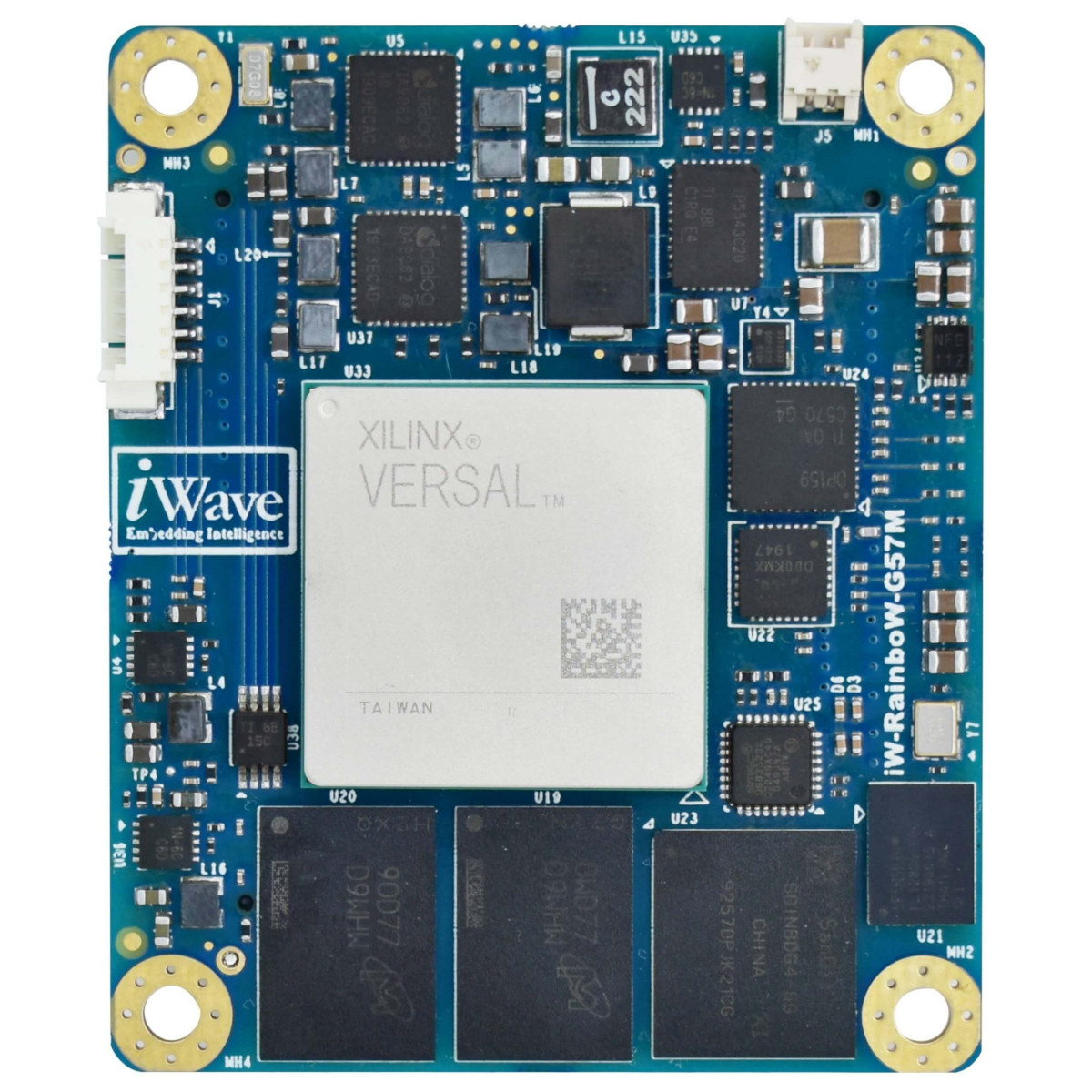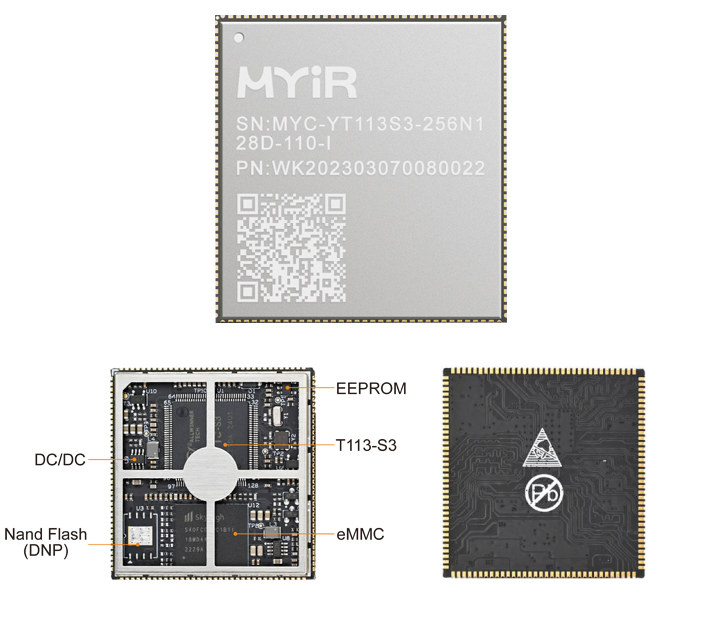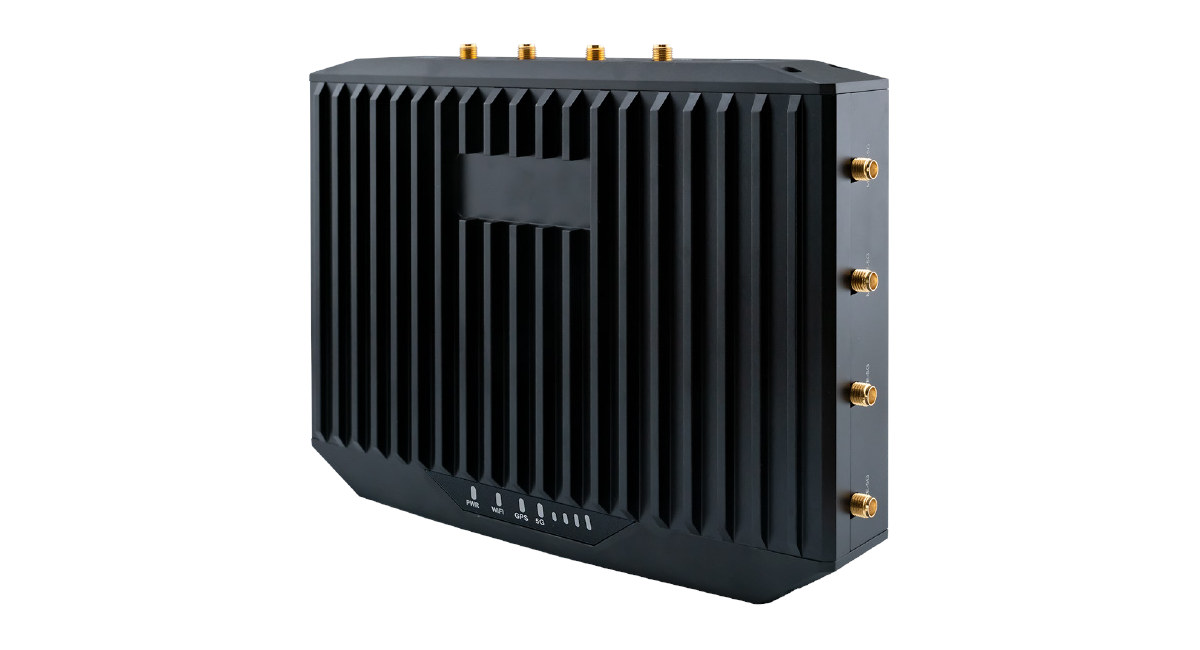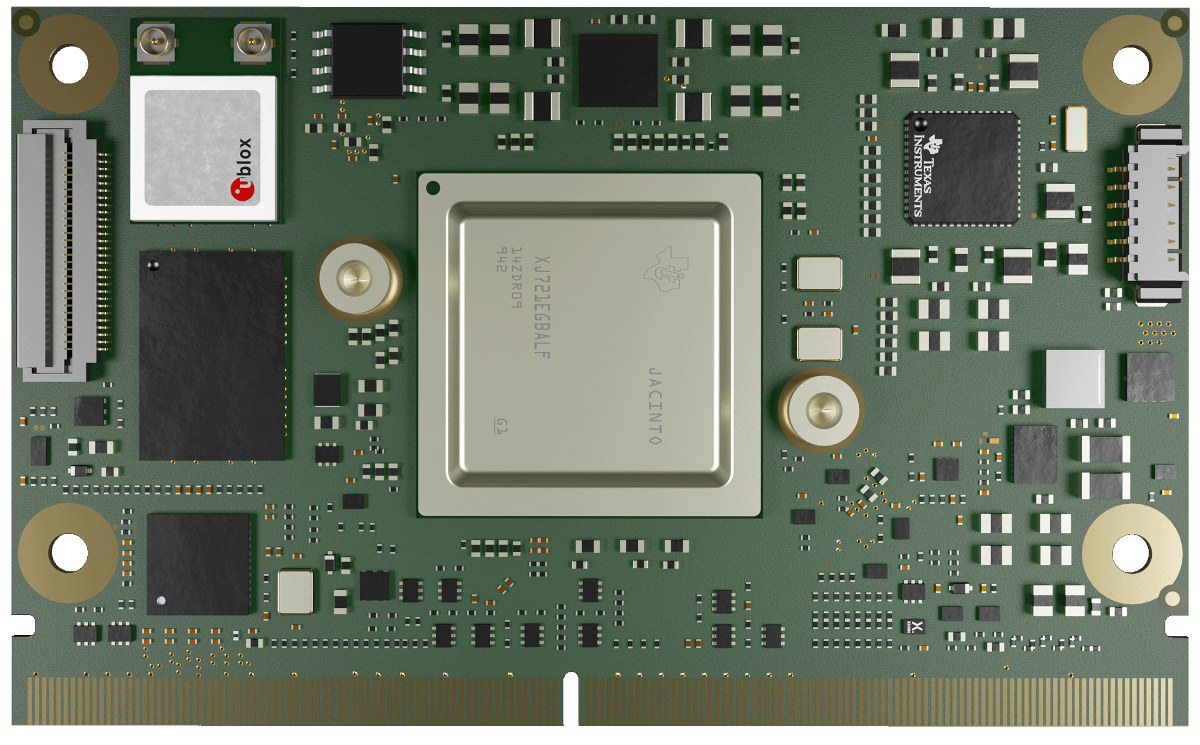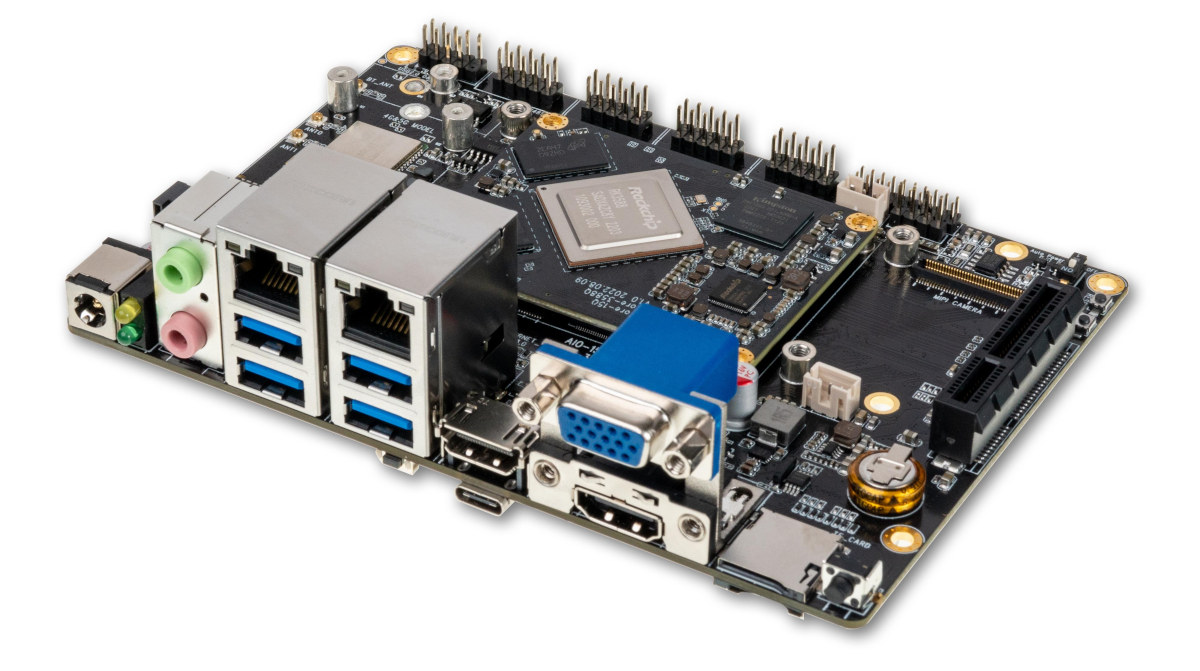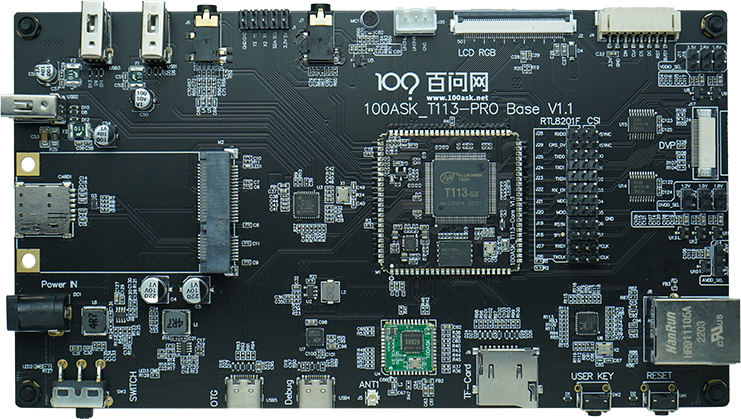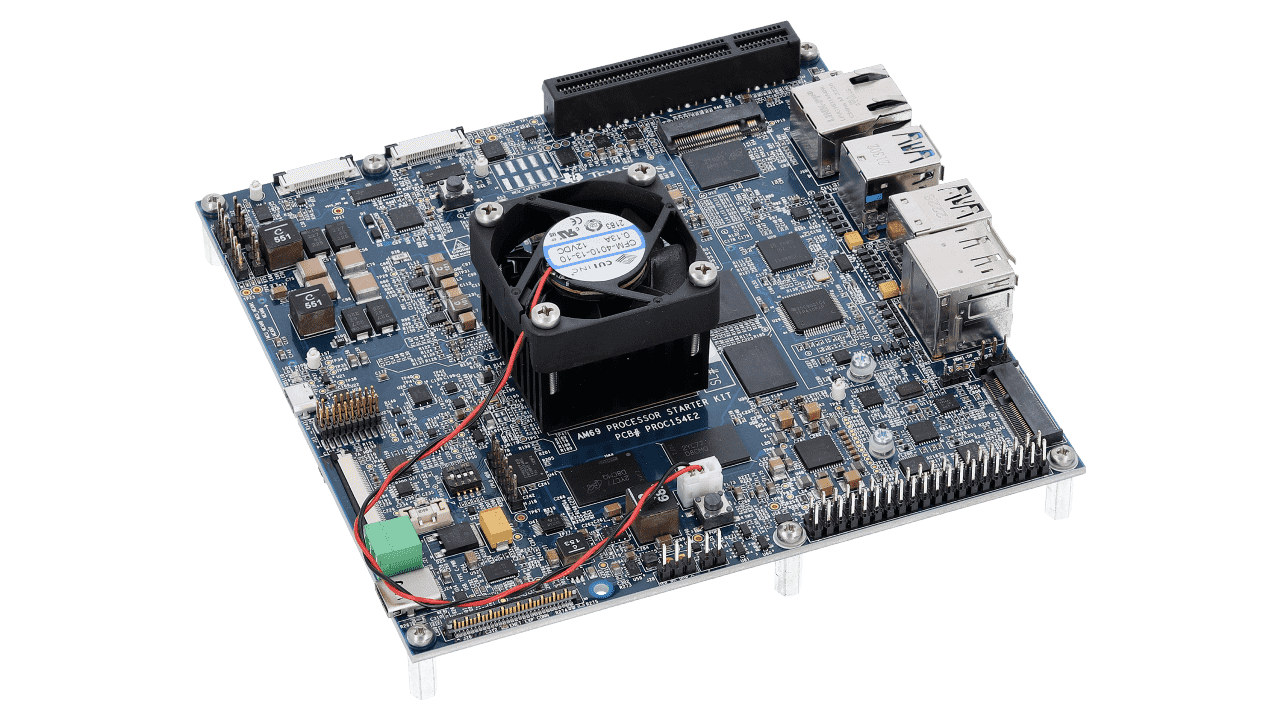iWave Systems iW-Rainbow-G57M is a system-on-module (SoM) based on the AMD (Xilinx) Versal AI Edge series of Cortex-A72/R5 SoC FPGAs designed to deliver AI acceleration at relatively low power for demanding applications such as ADAS, robotics, and medical imaging. The module comes with up to 8GB 64-bit LPDDR4, 16GB eMMC Flash, 256MB QSPI Flash, delivers up to 45 TOPS of AI performance, and features eight transceivers that can be used for high-speed Ethernet, PCIe, MIPI DSI/CSI interfaces, and/or others as required by the customer’s specific project. iW-Rainbow-G57M specifications: FPGA SoC – AMD Xilinx Versal AI Edge/Prime SFVA784 package (VE2302, VE2202, VE2102, or VE2002) with Dual Arm Cortex-A72 core processor @ up to 1.6 GHz Dual-core Arm Cortex-R5F Up to 328K Logic cells & 150K LUTs Programmable Network on Chip (NoC) Up to 45 TOPS (INT4) AI compute 8x GTYP Transceivers @ 28.21 Gbps (VE2302 & VE2202 only) Memory – Up […]
$14+ Allwinner T113-S3 CPU module comes with 128MB RAM, 256MB NAND flash or 4GB eMMC flash
MYiR MYC-YT113X is a low-cost solderable CPU module powered by an Allwinner T113-S3 dual-core Cortex-A7 processor with 128MB on-chip DDR3 RAM, and fitted with either a 256MB NAND flash or a 4GB eMMC flash for storage. The industrial temperature grade module provides a lower-end alternative to the company’s earlier MYC-YT507H Allwinner T507-H Cortex-A53 CPU module, and offers various display, camera, audio, Ethernet, USB, and low-speed I/Os through a 140-pin stamp hole design. It is designed for HMI, industrial automation, as well as display and control terminals. MYiR MYC-YT113X specifications: SoC – Allwinner T113-S3 CPU – Dual-core Arm Cortex-A7 @ 1.2 GHz with 32 KB L1 I-cache + 32 KB L1 D-cache per core, and 256 KB L2 cache DSP – Single-core HiFi4 VPU – H.265/H.264 video decoding up to 1080p60 and JPEG/MJPEG video encoding up to 1080p60 Memory – 128 MB DDR3 Storage – 4GB eMMC or 256MB NAND flash, […]
Embedded Open Source Summit 2023 schedule – Zephyr OS, Security, IoT, Embedded Linux, and more
The Linux Foundation has just announced the full schedule for the Embedded Open Source Summit, which will take place on June 27-30, 2023 in Prague, Czech Republic, as well as virtually starting on June 26. Over 175 sessions, birds of a feather (BoF) tracks, and workshops related to embedded and open-source innovation will be presented at the event itself comprised of six micro conferences: Automotive Linux Summit Europe, Embedded IoT Summit, Embedded Linux Conference, LF Energy Embedded Summit, Safety-Critical Software Summit, and Zephyr Project Developer Summit. Even though I’m not going to attend personally, I’ve gone through the schedule to create my own little virtual schedule with some sessions relevant that should be interesting to me and hopefully to CNX Software readers. Monday, June 26 (Virtual sessions) The first day of the event will have a Yocto Dev training in the morning, and a bunch of virtual sessions that are […]
Queclink WR300FG – A 5G industrial router with GbE, Wi-Fi 6, GNSS, RS232 and RS485 interfaces
Queclink Wireless Solutions WR300FG is a dual SIM 5G industrial router with five Gigabit Ethernet ports, WiFi 6, GNSS, RS232 and RS485 interfaces designed for factory automation, smart energy infrastructure, and Internet of Vehicles (IoV). TheWR300FG is based on a Qualcomm IPQ8072 quad-core Arm Cortex-A53 networking processor running OpenWrt, supports both 5G SA/NSA modes, backward-compatibility with 4G/3G, and its dual SIM features enabled automatic switchover for interrupted 5G connectivity. WR300FG specifications: SoC – Qualcomm IPQ8072 quad-core Arm Cortex-A53 @ 2.2 GHz part of Qualcomm Networking Pro 1200 Platform System Memory – TBD Storage – 1GB flash (described as “hard disk” in the press release!) Connectivity Cellular 5G SA, 5G NSA, 4G LTE, 3G UMTS Operating bands 5G NR – n1/n2/n3/n5/n7/n8/n12/n20/n28/n38/n40/n41/n48/n66/n71/n77/n78/n79LTE-FDD: B1/B3/B5/B7/B8/B18/B19/B20/B26/B28/B32 LTE-TDD: B34/B38/39/B40/B41/B42/B43 WCDMA: B1/B2/B4/B5/B6/B8/B19 2G GSM: 850/900/1800/1900 MHz Data rates 5G SA: DL 2.1Gbps; UL 900Mbps 5G NSA: DL 2.5Gbps; UL 650Mbps LTE-FDD: Max 150Mbps (DL)/Max 50Mbps (UL) […]
conga-STDA4 SMARC 2.1 module features TI TDA4VM/DRA829J Jacinto 7 processor
congatec conga-STDA4 is a SMARC Computer-on-Module (CoM) based on Texas Instruments TDA4VM or DRA829J Jacinto 7 processor with two Cortex-A72 cores, six real-time Cortex-R5 cores for functional safety, accelerated vision and AI processing capabilities, and plenty of interfaces. The first Texas Instruments-powered CoM from the company is designed for industrial mobile machinery requiring near-field analytics, such as automated guided vehicles and autonomous mobile robots, construction and agricultural machinery, as well as any industrial or medical solutions requiring energy-efficient computer vision at the edge. conga-STDA4 specifications: SoC – Texas Instruments Jacinto 7 TDA4VM/DRA829J with Dual-core Arm Cortex-A72 up to 2.0 GHz 6x Arm Cortex-R5F cores @ 1.0 GHz up to 8 MB of on-chip L3 RAM 1x C7x DSP up to 80 GFLOPs 2x C66 DSPs up to 40 GFLOPs Up to 8 TOPS MMA AI accelerator PowerVR Rogue 8XE GE8430 3D GPU with support for OpenGL ES 3.1, OpenVX, OpenCL […]
Rockchip RK3588M automotive-grade AI SoC supports up to 16 camera inputs
Rockchip RK3588M is an automotive-grade variant of the Rockchip RK3588 octa-core Cortex-A76/A55 SoC that supports at least 6 Full HD displays and 16 camera inputs and can simultaneously run the car dashboard, in-vehicle infotainment, a digital rearview mirror, headrest monitors, ADAS system, and more. The frequency of the Cortex-A76 cores is limited to 2.1 GHz, and the Cortex-A55 cores to 1.7 GHz, against 2.4 and 1.8 GHz for RK3588, probably to operate in a larger temperature range required by the automotive market. I could not find any RK3588M datasheet yet, but we can find more details through the Firefly AIO-3588MQ automotive mainboard built around the RK3588M processor. Firefly AIO-3588MQ specifications: SoC – Rockchip RK3588M octa-core processor with CPU 4x Cortex-A76 cores @ up to 2.1 GHz, 4x Cortex-A55 cores @ up to 1.7 GHz Arm Mali-G610 MP4 GPU with OpenGL ES 3.2, OpenCL 2.2, Vulkan 1.1 support 6 TOPS AI […]
100ASK-T113-Pro Allwinner T113-S3 industrial board, and Allwinner T113-S4 with 256MB DDR3
Last year, Jean-Luc introduced the T113-S3 processor and the small MangoPi-Dual board with T113-S3. This time, I will introduce a development board with relatively rich resources, the 100ASK-T113-PRO, which consists of a core board with T113-S3 and a carrier board with a large number of peripheral interfaces, and the upcoming Allwinner T113-S4 SoC with 256MB DDR3. 100ASK-T113-Pro Allwinner T113-S3 industrial board While the T113-S3 and D1s/F133 RISC-V processors are pin-to-pin compatible, the T113-S3 is a dual-core Arm Cortex-A7 processor with HiFi4 DSP, CAN interfaces added (CAN is not mentioned publicly, but can be seen in the T113-S3 Datasheet) and 128MB DDR3 on-chip memory. 100ASK-T113-PRO preliminary specifications: T113-S3 Core Lite: SoC – Allwinner T113-S3 CPU – Dual-core Arm Cortex-A7 with 32 KB L1 I-cache + 32 KB L1 D-cache per core, and 256 KB L2 cache DSP – Single-core HiFi4 Memory – 128 MB DDR3 (SIP) Storage – 16MB SPI NandFlash […]
Texas Instruments unveils AM62A, AM68A and AM69A Arm Cortex Vision processors and devkits
Texas Instruments AM62A, AM8, and AM69A Arm Cortex-A53 or Cortex-A72 Vision processors come with 2 to 8 CPU cores and deep learning accelerators delivering from 1 TOPS to 32 TOPS for low-power vision and artificial intelligence (AI) processing in applications such as video doorbells, machine vision, and autonomous mobile robots. Three families and a total of 6 parts are available: AM62A3, AM62A3-Q1, AM62A7, and AM62A7-Q1 single to quad-core Cortex-A53 processors support one to two cameras at less than 2W in applications such as video doorbells and smart retail systems. Equipped with a 1TOPS vision processor, the AM62A3 is the cheapest model of the family going for US$12 in 1,000-unit quantities. AM68A dual-core Cortex-A72 processor can handle one to eight cameras in applications like machine vision, with up to 8 TOPS of AI processing for video analytics. AM69A octa-core Cortex-A72 SoC supports up to 12 cameras and achieves up to 32 […]


